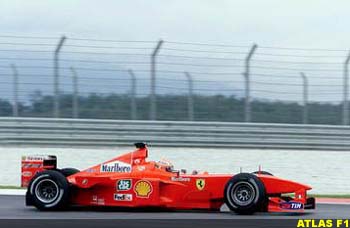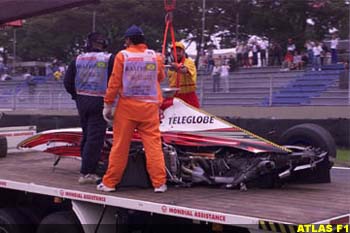|
| |||
 |
Taking the Lid Off F1 Formula One Technical Analysis | ||
| by Will Gray, England | |||
|
Atlas F1 presents a series of articles by certified engineer Will Gray, that investigates in greater depth all the technical areas involved in design, development, and construction of a Formula One car.
Keeping trim is not only important from the drivers' point of view. Like a light person, a light car is easier to accelerate and brake, and more responsive and controllable when in motion! It is for this reason that Carbon Fibre is used all over the modern Formula One car, and that designers are always trying to shave grams off this and that, taking designs as close to their tolerable limits as possible. The power to weight ratio is an all-important figure. It gives a guide to the straight-line acceleration capability, and simply the more power and the less weight you have, the faster you will accelerate. Weight saving is big business. Although almost every car in the field is below the minimum weight limit, their designers still try to reduce the car's weight further. The reason for this is the weight has to be made up with ballast, which can be put anywhere on the car, and made any shape the designer wants. This is an advantage, as it is not only low weight that enhances the performance of the car, there are a number of other criteria to consider. The weight of the vehicle is put into two categories - sprung and unsprung. The sprung weight is all that acts through the springs - most of the car, including driver and fuel. Unsprung weight is that which is supported by the tyre and put directly on the road - basically the suspension, wheels and brakes. There is little to be done to reduce unsprung weight, except using carbon brakes instead of steel, light wheels (often magnesium), and carbon fibre suspension. For that reason, most weight reduction tends to concentrate on the sprung mass.
However, it is not only vertical centre of gravity position designers are interested in - it must be on the centerline of the car, and its position between the front and rear wheels will determine how the braking and accelerative forces is spread between the two sets of wheels. It is good to have the static weight distribution such that the centre of gravity is positioned closer to the rear of the car, as this puts more weight on the rear wheels and provides more traction. As well as this, the vehicle should have a low polar moment of inertia - ooh, scary! This basically means how easy it is to move the thing around, and if the designer concentrates the weight close to the centre of gravity, he can achieve this, and obtain a responsive racecar. These criteria are, of course, also dependent on where the wheels are in the first place - and the F1 wheelbases are so long that with a low centre of gravity and such stiff suspension, squat and dive are significantly minimized. Any wheelbase changes are often to change static load distribution and reduce weight transfer rather than improving stability. Another area of concern is the roll centre. When a vehicle corners, it is subject to a lateral force - tie a full can of drink to a piece of string (securely!) and swing it around and you'll feel the force! This centrifugal force acting on the can is resisted by your hand - on the car the centrifugal force acts on the chassis and is resisted by the tyre's grip with the road. This force, acting on the body through the suspension, will cause it to roll, and the weight distribution around the car, as well as suspension design, will determine about what point it will do so.
So designers go to great lengths to reduce the weight from some places to put it into others. One favorite is putting metal in the wooden planks that run under the floor of the car. This is acceptable ballast, and it is as low as they can go! The more weight the designer (including the engine designer I might add) can remove, the more they have to put in the right places. Removing weight, unless it involves a change in material which gives similar properties for reduced weight (such as the move from aluminum to carbon fibre), involves shaving dimensions and cutting out metal where it isn't needed - for instance, a front wing is hollow, as it is strong enough to not need any internal supports. However, sometimes the designers cut it too fine, and when they remove too much material, or use too small a dimension for the job, the part will fail. There is a fine line between building a car which is light but unreliable, and creating one which is a little heavier, but can drive around the circuit all day without a hic-up... and unlike a person, it is far harder to put weight back on than it is to take it off!
Previous Parts in this Series: Parts 1 & 2 | Part 3 | Part 4A
|
| Will Gray | © 1999 Kaizar.Com, Incorporated. |
| Send comments to: gray@atlasf1.com | Terms & Conditions |

 When we consider weight, we must consider fuel. This is the only part of the car, which significantly decreases in weight as the race goes on, and with refueling allowed it is a major area for strategy choice - one stop or two? This depends on the track, the tyre condition, and traffic - it is often the case that a team will have many different fuel strategies, and they can choose a different one for a different race case, such as being stuck behind a slower car, or coming into the pits to avoid that very situation.
When we consider weight, we must consider fuel. This is the only part of the car, which significantly decreases in weight as the race goes on, and with refueling allowed it is a major area for strategy choice - one stop or two? This depends on the track, the tyre condition, and traffic - it is often the case that a team will have many different fuel strategies, and they can choose a different one for a different race case, such as being stuck behind a slower car, or coming into the pits to avoid that very situation.